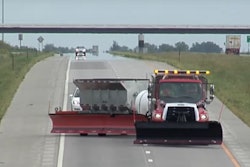 Sample cross-sections from trenching after the end of performance monitoring. Photo courtesy of IAAP.
Sample cross-sections from trenching after the end of performance monitoring. Photo courtesy of IAAP.Researchers at the Illinois Center for Transportation (ICT) are working with the Illinois Department of Transportation (IDOT) to find a way to reduce waste fines, or quarry by-product (QB), in quarries by using them to improve pavement sustainability and longevity, according to a report in the Illinois Association of Aggregate Producers (IAAP) Update newsletter.
The research project, R27-168, “Field Performance Evaluation of Sustainable Aggregate By-product Applications,” is being directed by Professors Erol Tutumluer and Hasan Ozer of ICT at the University of Illinois at Urbana-Champaign, and Ph.D. Civil Engineering candidate Issam Qamhia.
The researchers constructed 12 hot-mix asphalt (HMA) roadways and four construction platform test sections at the Advanced Transportation Research and Engineering Laboratory (ATREL) of ICT and subjected them to real-life traffic and environmental conditions. The test sections included a conventional pavement, two inverted pavements with a conventional aggregate base on top of a strong chemically stabilized subbase, and five pavements with chemically stabilized QB aggregates blended with recycled aggregates as a base.
Stabilizers (cement and Class ‘C’ fly ash), various recycled materials, and QB aggregates were used to improve the service life of the pavement. Each pavement was evaluated for surface deformation (rutting) and fatigue using the Advanced Transportation Loading Assembly (ATLAS).
The study concluded that all five sections with chemically stabilized QB aggregate base and the two inverted pavement sections, particularly the one with cement-stabilized QB aggregates, performed well, which could be a result of reduced stresses on weak supporting subgrade soil. The pressure on top of the subgrade soil was measured at three to five times lower than pavements constructed using conventional aggregate base materials.
Tests were conducted to verify the outcome of the loading tests, including falling weight deflectometer and dynamic cone penetration. In addition, sections were flooded with water to verify their susceptibility to water and then trenched to observe any physical changes.
Results from the study showed that QB aggregates can be used in standard pavement construction to enhance stability and lower permanent deformation of subgrade soils, thereby reducing environmental and economic impacts at quarries.
“Through test section construction and accelerated pavement testing, this research has successfully demonstrated in the field the effective uses of QB aggregates and QB aggregates mixed with 6-inch stones for building more sustainable, longer-lasting, and resilient road infrastructure,” said project Principal Investigator Erol Tutumluer, according to the news outlet. “These beneficial applications of QB aggregates will no doubt improve the efficiency of aggregate production and provide state and local agencies with economical road construction alternatives and environmental benefits.”
“This research has shown that QB aggregates blended with cement can improve the performance of base, subbase, and subgrade layers,” said IDOT Engineer of HMA, Aggregate and Chemical Tests, and project Technical Review Panel Chair Jim Trepanier, according to the newsletter. “The key to successful widespread usage of the QB aggregates will be to identify cost effective means to apply the blended QB aggregate products in these applications.”











